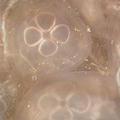 據美國國家科學基金會(National Science Foundation)最新線上報告指出,目前全球多處著名景點,包括美國海域皆陷入水母遽增危機。報告中說,全球每年有1.5億人會遭遇到水母,大批蜂擁而至的水母和類水母,把許多世界級漁場和景點變成了「水母觀光區」,水域中時不時就擠滿這些帶刺蠕動的膠狀生物。
據美國國家科學基金會(National Science Foundation)最新線上報告指出,目前全球多處著名景點,包括美國海域皆陷入水母遽增危機。報告中說,全球每年有1.5億人會遭遇到水母,大批蜂擁而至的水母和類水母,把許多世界級漁場和景點變成了「水母觀光區」,水域中時不時就擠滿這些帶刺蠕動的膠狀生物。
科學家稱此現象為「水母大爆炸」,部分科學家認為這與人類活動有關,可能原因包括:污染、氣候變遷、外來種引進、過度魚撈及人為設施如油田與天然氣船具。
暴增的水母除對漁業、漁場、海床採礦作業、海水淡化場造成損失,甚至堵塞排水孔使得核電廠停止轉動。
在墨西哥灣(Gulf of Mexico)水母最密集的水域中,水母甚至比水還要多──每立方米水體有100隻水母。位於灣區、隸屬於美國阿拉巴馬州的多芬島海洋實驗室(Dauphin Island Sea Lab),其發言人葛理翰(Monty Graham)表示:「我常被問及,是否背後有一股驅力觸發水母的遽增。事實上,那些異常巨大且密集經常出現的水母群顯示的正是環境負載平衡問題。」
就如同體弱的人容易染病,不健全的生態系統則容易召來大批水母。
在食物鏈裡,海鳥、鮭魚、翻車魚、海龜以及其他膠狀生物皆以水母為食。一旦海龜少了,水母即加速生長。然而會以水母為食的七種海龜卻全盤面臨絕種危機。他們的生存受到釣繩、海洋污染、濱海發展、氣候變遷以及海龜買賣的威脅。
 但水母也非一無是處,有科學家就證實膠狀生物可以提供生態服務。例如:近來有研究指出在白令海峽(Bering Sea)某種鮭魚生長在巨型水母懸掛的觸角下,以躲避天敵,因為長得過大即使水母想吃也吃不到。
但水母也非一無是處,有科學家就證實膠狀生物可以提供生態服務。例如:近來有研究指出在白令海峽(Bering Sea)某種鮭魚生長在巨型水母懸掛的觸角下,以躲避天敵,因為長得過大即使水母想吃也吃不到。
據美國國家科學基金會指出,大部分的水母及類水母生物都無害人體。但報告也警告人們注意所有水母及類水母生物身上的刺──事實上單一個觸腳上就有數以千計的針刺。
報告提出忠告,小心為上,當心海域裡每個對人們有害的膠狀生物。欲瀏覽報告詳細內容,可到該基金會網站觀看。
Jellyfish blooms are ruining some of the world's most beautiful vacation spots, according to a new online report by the National Science Foundation on massive jellyfish swarms in U.S. waters and around the world.
At least 150 million people around the world are exposed to jellyfish every year, the report says. Swarms of stinging jellyfish and jellyfish-like animals are transforming many world-class fisheries and tourist destinations into "jellytoriums" that are intermittently jammed with the pulsating, gelatinous creatures.
These jellyfish explosions are generated by human activities, some scientists believe. Possible causes include pollution, climate change, introductions of non-native species, overfishing and the presence of artificial structures, such as oil and gas rigs.
Jellyfish swarms have damaged fisheries, fish farms, seabed mining operations, desalination plants and large ships, and they have disabled nuclear power plants by clogging intake pipes.
In the Gulf of Mexico's densest jellyfish swarms there are more jellyfish than there is water - 100 jellyfish can occupy each cubic meter of water.
"I'm often asked whether a single, overarching condition is triggering jellyfish swarms in diverse locations," says Monty Graham of Alabama's Dauphin Island Sea Lab on a barrier island in the Gulf of Mexico. Graham says the abnormally large, dense or frequent jellyfish swarms are "a symptom of an ecosystem that has been tipped off balance by environmental stresses."
So, just as a weakened person is vulnerable to opportunistic diseases, stressed ecosystems are vulnerable to infestations of jellyfish.
As prey, jellyfish are eaten by seabirds, salmon, sun fish, turtles and other gelatinous creatures.
But as marine turtles have disappeared, jellyfish have proliferated. All seven species of sea turtles eat jellyfish and all seven species are endangered. Their survival is threatened by fishing lines that trap them, pollution, beach development, climate change and sales of turtles and turtle parts.
Jellyfish are not all bad - scientists are identifying ecological services provided by the gelatinous creatures. For instance, recent studies show that the tentacles dangling from the Bering Sea's large jellyfish provide hiding places for young pollock that are pursued by other predators but have grown too big for the jellyfish to eat.
Most species of jellyfish and jellyfish-like animals are not harmful to people, according to the National Science Foundation report. But it warns that all true jellyfish and some species of jellyfish-like creatures sting - and a single stinging tentacle may be studded with thousands of stingers.
Beware, warns the report. Gelatinous creatures that are harmful to people live in every ocean.
Click here to view the report, "Jellyfish Gone Wild: Environmental Change and Jellyfish Swarms."



